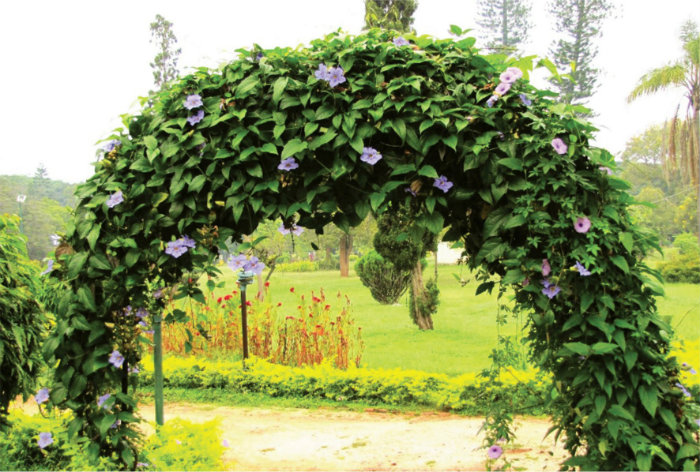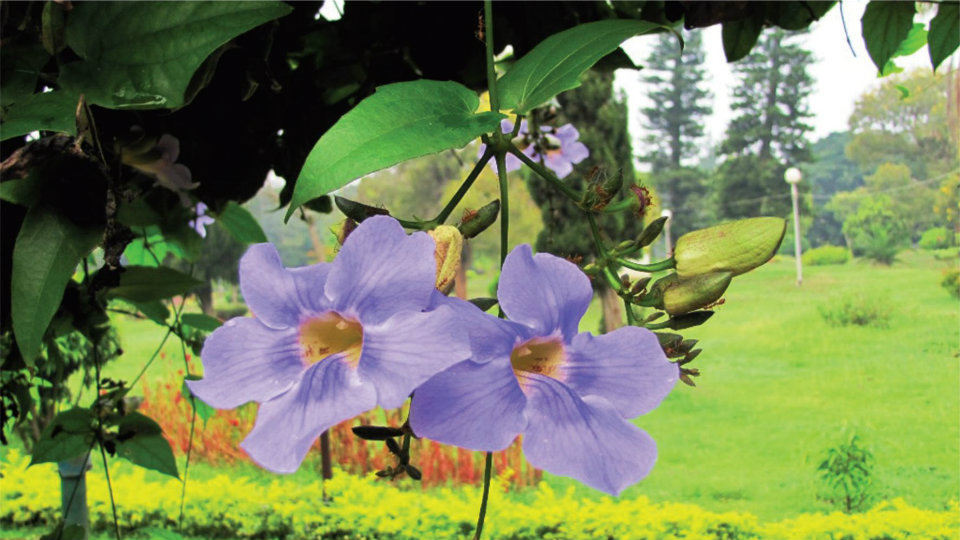Climbers are an integral part of any garden. Perching on trees, resting on low roofs, high buildings, twining on arches, pergolas and trellises, they display dazzling beauty with decorative foliage and colourful blooms often with sweet fragrance.
One of the prettiest climbers, which grows luxuriantly in Mysuru’s salubrious climate is “The Bengal Clock Vine.” The curious name ‘clock vine’ comes from the fact that it twines around a support in a clockwise direction. With gorgeously showy flowers and lush foliage, it is popular because of its easy culture. In my view, it is the best among the climbers and a choice addition to any garden.
It is known by many other names such as “Bengal Trumpet”, “Bengal Clock vine”, “Indian Sky Flower”, “Sky Vine”, “Blue Trumpet Vine”, “Blue Sky Flower”, “Blue Thunbergia”; Hindi: Neel latha. The scientific name is “Thunbergia grandiflora” belonging to the family Acanthaceae. The genus ‘Thunbergia’ is named after Carl Peter Thunberg, a Swedish doctor who studied under Carl Linnaeus.
The specific epithet is from the Latin words ‘grandis’ meaning “great” or “large” and ‘flora’ meaning “flower” in reference to the flowers which are large for the genus. It is native to West Bengal, North Eastern India, China, Nepal and Burma.
The handsome Thunbergia grandiflora is a perennial evergreen plant. A rampant climber, the stems are hardy with woody stems. With its vigorous growth tendency, it has the spreading habit. A rapid grower, it needs support and the rope-like stems can reach to the top of large structures or even cover moderate-sized trees. The simple leaves are arranged in opposite or sub-opposite position on stems. They possess distinctive elongated heart shape varying from ovate to elliptical, often with slightly toothed margin, 10-20 cm long. They are dark green, leathery and softly hairy.
The flowers are borne singly or in pendent racemes (drooping clusters). They are trumpet shaped, a little deeper, about 3” long, pale blue or white cup-like with pale yellow to cream blue striped centres. The fruit, which is called a capsule, is inconspicuous and not showy.
There are two varieties: ‘Augusta’ – The most common variety. Flowers lavender blue to violet blue with yellow throats; ‘Alba’ – White flowers with a yellow throat.
Another species of Thunbergia, which is closely related to and often mistaken for T. grandflora, is T. laurifolia, which produces pale mauve flowers. It is not so dense as T. grandiflora.

Useful Tips
It is ideal for trailing over arches, pergolas, arbours and trees. It is also suited for covering fences, trellises and tennis courts.
The sky vine gives an artistic and natural look to a building when they are spread over an iron netting or a portico or hung from a veranda or a balcony.
It can be successfully used for cascading over a wall or as a screen. Also looks best when grown on a tree where it can freely spread and flower.
Though it is ideal for planting on the ground it can be grown successfully in containers too but one has to use cement pots of big size.
If grown on a support it needs drastic pruning to keep it within bounds. However, the vigorous pruning is harmful and may prevent free flowering. It is better to trim carefully (not to cut up to the base). It blooms on new wood after rains.
The plant blooms profusely during March and October in good fertile soil.
For better propagation (quick rooting and improved performance) dip the bottom end of the stem cuttings in the hormone powder. Then shake off the extra powder and plant in the soil media.
Plant can also be used in floral arrangements. Use both blossom and foliage.
Propagation
The plant can easily be propagated from stem cuttings or layers. Take green mature stems of 6” length for stem cuttings. It is better if the lower cut is slant and about ½” below the node. Plant the cuttings in soil mixture (sand, leaf mould and FYM in the ratio of 2:1:1) and water regularly both morning and evening. The cuttings initiate root and produce fresh buds within a month. For layering, bend down a branch at the lower side of the plant into a small pit made in the soil or into a pot. Cover the bent branch with soil mixture and put a small brick over it to secure the bent stem. Otherwise the branch will slip off. After rooting, separate the layer from the mother plant and plant in a pit or pot. Plant at a distance of 5’ in pits of 2’ x 2’ x 2’ size filled with recommended soil mixture with ½ kg bone meal powder for each pit.
Gardening
The plant prefers full sun to part shade and tolerates drought moderately. It can be grown in any type of soil ranging from acidic to alkaline, sandy loamy to clay. Nevertheless, it prefers moist well-drained fertile soil. The recommended soil mixture is 1:1:1:1 (sand, red soil, FYM and leaf mould).
Text & photographs by Dr. Mahadeswara Swamy, Scientist (Mob: 97429-91057) e-mail: [email protected]








Recent Comments